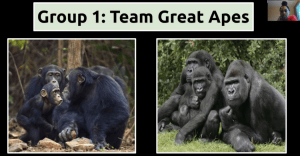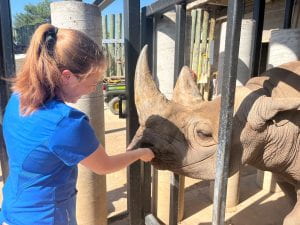
Macho the black rhino greets his adoring fans before undergoing routine venipuncture.
My experience as a first-year vet student in 2020 was largely shaped by the pandemic and the many limitations it imposed. When I first learned about the Abilene Zoo in April 2021, it was through a Cornell Zoo and Wildlife Society (ZAWS) lecture given by Dr. Stephanie Carle, the Abilene Zoo’s senior veterinarian, over Zoom. Spending my lunch hour puzzling through case-based questions with my classmates (albeit virtually) offered a glimpse into the many opportunities available to us as veterinary students—something I had lost sight of somewhat amid the organized chaos of first year. Dr. Carle concluded her talk by discussing the Abilene Zoo’s veterinary externship program. Immediately, I had my sights set on participating in the program.
I had my chance in June 2022 when, funded by a Student American Veterinary Medical Association (SAVMA) Veterinary Experience Grant, I traveled to Abilene, Texas for a three-week externship. It was an adventure over a year in the making, and despite how high I had allowed my expectations to climb in that time, the experience managed to exceed them.

Daphne enjoys her morning feeding!
The Abilene Zoo is home to over 280 species. The first resident I met upon my arrival was also one of the zoo’s newer residents. Daphne is a giant anteater who was born at the zoo in March of 2022 and, upon my arrival, was living in the clinic to receive round the clock care from the zoo’s veterinary and animal care staff. Daphne is a twin, and her mother was unable to care for both Daphne and her twin brother Arnaud. With input from zoos across the country, the Abilene Zoo was able to craft a customized care plan for Daphne that allowed her to gain weight and overcome a myriad of complications so that by the time I met her, she was thriving.
During my time at the zoo, I had the opportunity to bottle feed Daphne and to accompany her on her excursions to see the zoo and interact with her anteater family members. As I told Daphne during one of her late-night bottle feedings, I am also a twin and, unlike my sister, I spent an extended period in the hospital as a baby. I thought Daphne might appreciate that we were kindred spirits. (Her expression remained pretty neutral, so it’s hard to say if the point hit home. Perhaps I saw the corner of her long snout pull up in a smile.)
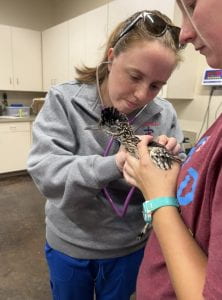
One of the zoo’s resident roadrunners undergoes a pre-shipment exam.
While I spent lots of time with Daphne, I also had opportunities to interact with many of the zoo’s species. Highlights of my experience included assisting with a pre-shipment exam for a roadrunner, helping to treat pododermatitis in one of the zoo’s resident flamingoes, participating in a neonatal exam of a steenbok, and medicating a capybara with conjunctivitis.
Other favorite opportunities included monitoring Jamie, a heavily pregnant giraffe in the zoo’s herd, and examining Rico, a fossa hospitalized after fracturing his humeral condyle. I was ultimately able to travel with a team from the zoo to Dallas Veterinary Surgical Center to observe Rico’s orthopedic surgery.
When I wasn’t seeing cases in the hospital with Dr. Carle and Dr. Mike Nance, the zoo’s second veterinarian, I was able to explore the zoo and gained a better understanding of the husbandry practices used by zoo staff to keep the collection animals healthy and happy. I was also able to participate in events hosted by the zoo, including Dreamnight, a cost-free event allowing children with special medical needs to enjoy the zoo with their families. This allowed me to feel at home in Abilene.
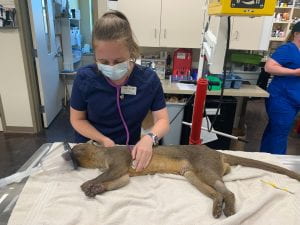
Rico the fossa receives a physical exam after sustaining an orthopedic injury.
The Abilene Zoo is also home to a clinic exclusively for injured and orphaned native birds. While I worried that my bird experience was somewhat deficient when I arrived in Abilene, during my externship I was able to practice my diagnostic and clinical skills while also improving my native bird identification skills. I didn’t expect to enjoy my work in the rehabilitation center as much as I did. However, working towards returning wild birds to their habitats, thereby giving them a second chance and helping to support their ecosystems, was incredibly rewarding.
When I wasn’t at the zoo, I was grateful to be able to accompany Dr. Carle and Dr. Nance as they fulfilled their other professional obligations. During my three weeks, their enthusiasm for teaching and fielding questions never waned. I visited the Abilene Animal Services Adoption Center to complete evaluations of new small animal residents, and also joined Dr. Carle during her shifts at the local emergency clinic. There, I saw cases I likely wouldn’t have encountered in the northeast, including advanced heartworm disease and rattlesnake envenomation.
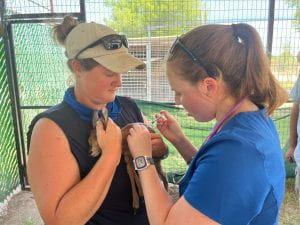
A neonatal steenbok undergoes her first exam.
I gained a great deal of knowledge from participating in the journal group at the zoo and working through sample cases with the veterinary team. I was able to live at the zoo throughout my externship, so my down time was spent conducting research and preparing a presentation I gave at the close of the externship on nutritional care for zoo animals.
I am tremendously thankful for all of the people and animals I met and learned from while in Abilene. I left this externship armed with new knowledge and skills, photos to cherish, mentors to look up to, and a newfound appreciation for Texas cuisine.
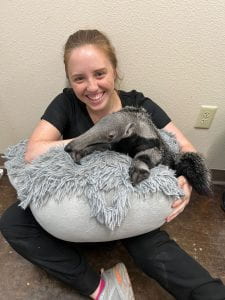
More bonding time with Daphne!
 Colleen Sorge, Class of 2024, is a Cornell DVM student from Long Island, NY. She obtained her undergraduate degree in Animal Science from Cornell University in 2020. She has a wide range of interests within the veterinary field, including both small animal and wildlife medicine.
Colleen Sorge, Class of 2024, is a Cornell DVM student from Long Island, NY. She obtained her undergraduate degree in Animal Science from Cornell University in 2020. She has a wide range of interests within the veterinary field, including both small animal and wildlife medicine.




 Carolina Baquerizo, Class of 2024, received her BS in Biological Science from Florida State University. She began volunteering at Zoo Miami when she was 15 and has held multiple zoological internships since then. She aspires to become a zoo veterinarian as a way to participate in
Carolina Baquerizo, Class of 2024, received her BS in Biological Science from Florida State University. She began volunteering at Zoo Miami when she was 15 and has held multiple zoological internships since then. She aspires to become a zoo veterinarian as a way to participate in 

 Hery Ríos-Guzmán, Class of 2024, obtained his Animal Science/Pre-Vet degree from the University of Puerto Rico – Mayagüez. The island environment in which he grew up influenced his professional interests and put him on the path to aquatic veterinary medicine. He has special interests in conservation medi
Hery Ríos-Guzmán, Class of 2024, obtained his Animal Science/Pre-Vet degree from the University of Puerto Rico – Mayagüez. The island environment in which he grew up influenced his professional interests and put him on the path to aquatic veterinary medicine. He has special interests in conservation medi